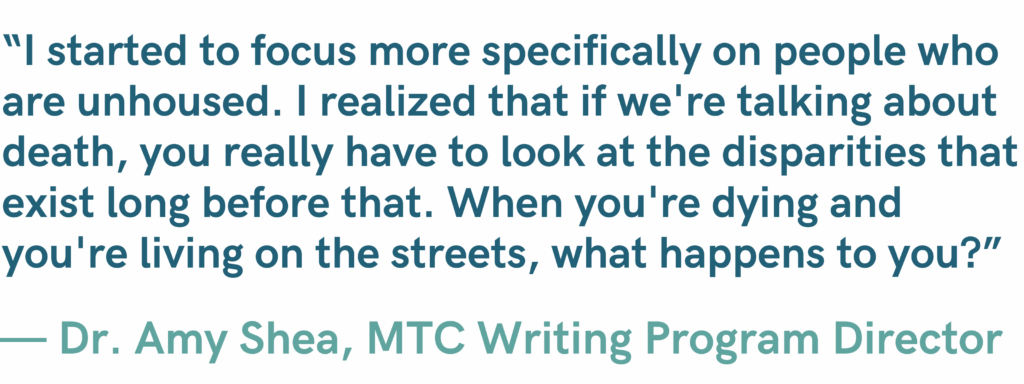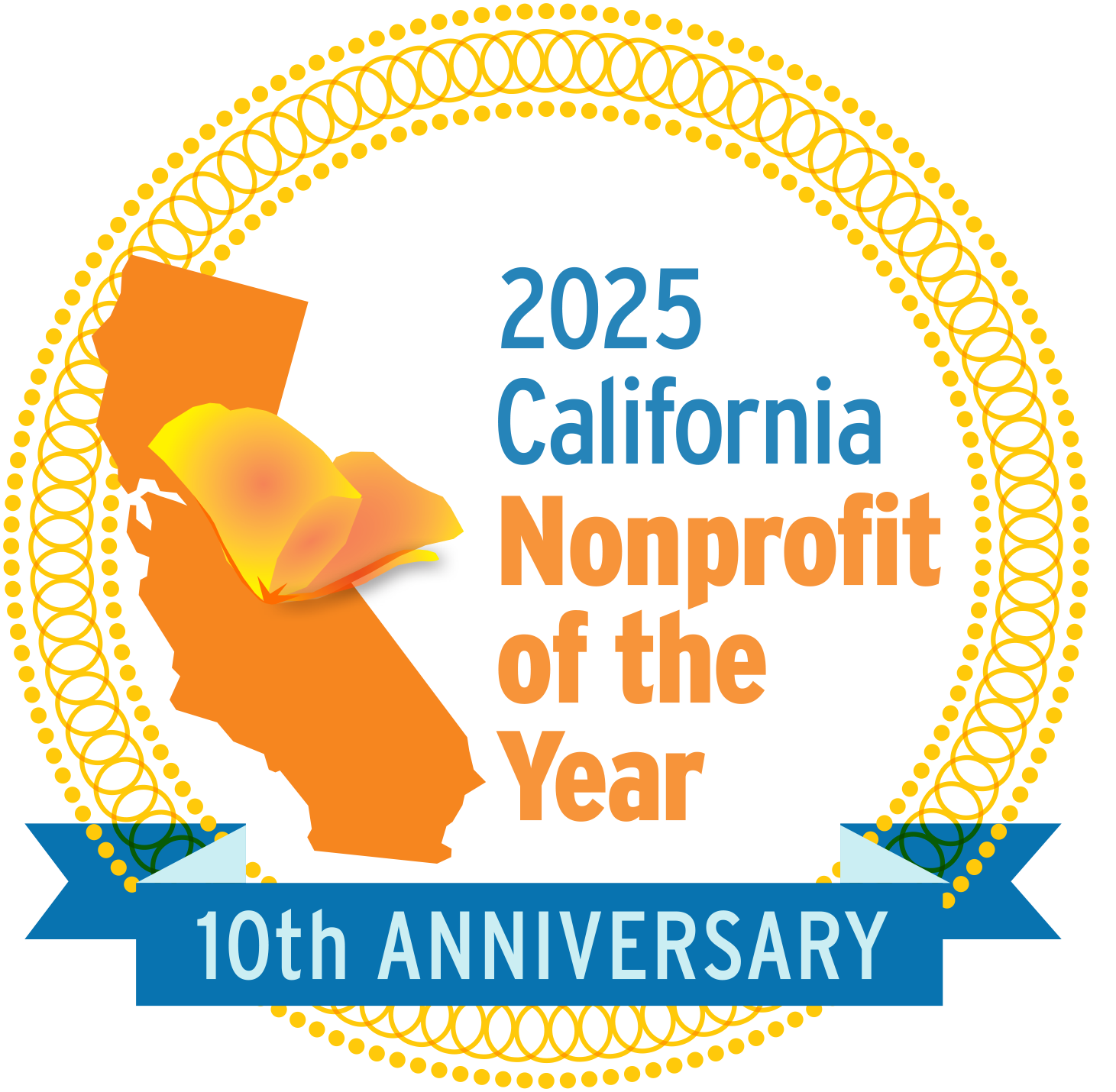In 2010, MTC Writing Program Director Dr. Amy Shea began visiting cemeteries in Fresno, CA. She was struck by what she saw—on one side of a fence stood a lush Catholic cemetery with rows of headstones; on the other, a barren field dotted with weeds.
“It just looked like a dirt field,” Amy said, describing the county’s public cemetery. “If you look really closely, you could see these strips of cement with numbers written on them, and those are the plot numbers. That’s the only indication that it’s a burial place.”
That stark contrast stuck with her. It was her first encounter with what would become the focus of a personal journey to understand how poverty and homelessness shape the experience of death and dying in America—a journey that would culminate in her debut book, Too Poor to Die: The Hidden Realities of Dying in the Margins, released on September 9 by Rutgers University Press.
The book, which Amy describes as “a collection of closely connected essays,” explores what happens to those who die while unhoused, unclaimed, or otherwise unable to afford burial services at the end of their life.

Amy’s interest in the subject stemmed from a volunteer project her father took up in retirement. He set out to map all the cemeteries in Fresno for the Genealogical Society. In the process, he discovered reams of public disposition records of people buried in county cemeteries—documents the county had no clear plan for managing or preserving.
“Those public cemeteries are also known as potter’s fields,” Amy explains. “Basically, when someone can’t afford private burial or cremation, the county handles it.” When her father told her about the project, Amy—then living in Boston—had never heard of the system. “I thought, ‘What the heck is a potter’s field?’” The biblical term, she later learned, refers to land historically used for burying the poor or unidentified.
“It’s interesting because historically, these sites have always been for people who are marginalized or poor, those in the fringes of society. And that has continued,” she explained. “It’s a term that still gets used today, but there is a move to get away from using it because of the stigma it carries.”
Her father eventually transformed those records into a database—now housed at the Fresno County Public Library—documenting the locations of more than 11,000 people buried in the county’s public cemeteries. The project became Amy’s first window into how inequity extends even beyond life.
Personal experiences deepened her curiosity. “Fresno was the initial thing, and then there were other elements,” Amy said. “My grandmother died a couple years later. I got really into death positivity, which is a whole movement of people who very much believe in the need to talk about death and dying, and that we need to be prepared for end of life.”
As Amy learned more about end of life scenarios and spent time volunteering at homeless shelters, her questions grew sharper. “It was all just swirling around in my writer brain. What about all these people who end up somewhere like a county cemetery, who might not have any agency in where they are buried, or how they’re memorialized, or even how they die?”
She began researching in earnest, a process that would span her MFA and PhD at the University of Glasgow. “I went down a rabbit hole, and here I am 13 years later,” she said. “I wrote a few essays, including a really long piece that I took to a workshop. Somebody read it and told me, ‘This is not an essay. This is a book.’ A year later, I went back to do my doctorate, and that’s where I really dove into the research.”
Amy’s investigation became a national one. She began reaching out to health workers and executives, coroners, hospice providers, and local government officials across the United States to understand how public disposition systems work. “I could not believe how hard it was to find information about what happens when somebody dies and goes financially unclaimed,” she said.
As she moved through her research, Amy’s focus shifted towards broader issues of inequality. “I started to focus more specifically on people who are unhoused. I realized that if we’re talking about death, you really have to look at the disparities that exist long before that. When you’re dying and you’re living on the streets, what happens to you?”
The structure of Too Poor to Die mirrors that evolution. “The book starts with the death side of things, gradually moves into the dying conversation, and then expands out a little bit to look at health care,” Amy explained. “I take people on the journey that I went on. I was really just trying to figure it all out—find these cemeteries, figure out how this happens, where it happens, how it works in other places.”
Amy emphasizes that her book is not written for people who have experienced homelessness, but for those who have never considered what dying in poverty might mean. “Unhoused people don’t need me to tell them what it’s like,” she said. “I want people who haven’t considered it before—just like me—to read this book.”
“We all know there are unhoused people, and most of the talk about solutions is aimed at figuring out how we can avoid seeing it, which can potentially make it harder for people to get out of that situation,” she added. Amy examined this dynamic in greater depth in her recent op-ed, The Wrong Way to Fight Homelessness, published in The Progressive Magazine.
“My goal is to humanize homelessness. And to make people think: How do you want the end of your life to go? I hope my readers take action with their own end of life plans. If you haven’t done that—and you have the ability to—go get some plans in place.”
Amy is already planning her next project, building on the questions raised in Too Poor to Die.
“A lot of people become unhoused because there’s a major loss in their life, whether it’s a divorce, job loss, or a death. I was surprised to learn that there were many people who hadn’t been homeless throughout their lives, and then suddenly became homeless as they were dying,” she said. “It has become a bigger issue in recent years, this aging into homelessness. And that has spurred my next book, which will focus on hospice and medical respite.”
This fall, Amy is sharing Too Poor to Die through readings and discussions across the country, including events in San Francisco, Boston, Philadelphia, New York, Louisville, Napa, Brooklyn, and Madison.
Learn More | Purchase | Upcoming Events | Follow on Social Media
About the Author
Dr. Amy Shea holds both a PhD and MFA in Creative Writing from the University of Glasgow, where she also wrote a collection of essays titled Not All Deaths are Created Equal. Her work has appeared in Portland Review, The Massachusetts Review, Spry Literary Journal, Fat City Review, From Glasgow to Saturn, and the Journal of Sociology of Health & Illness.
During her MFA studies, Amy taught a creative writing workshop at Barlinnie, a men’s prison in Glasgow, Scotland. She joined Mount Tamalpais College as Writing Program Director in 2021 after completing her PhD. Her work with students inside San Quentin continues to shape her thinking about inequality and marginalization.


